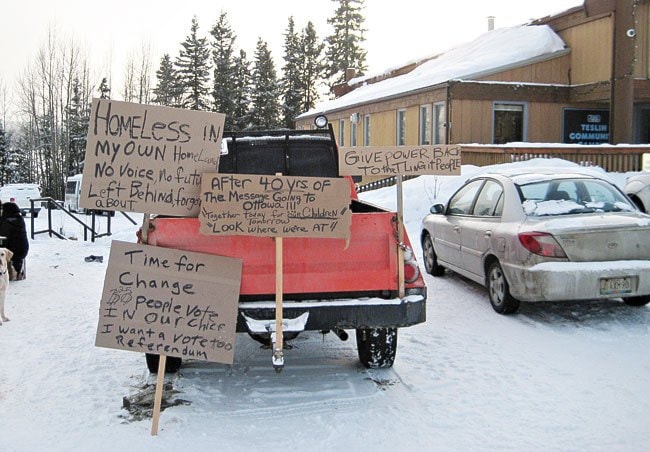Teslin Tlingit Council citizens are demanding more from the First Nation government.
Some of their concerns are familiar - more jobs and homes. But they also want something new: the chance to vote for their chief in a democratic way, just like all other First Nations in the Yukon do.
First Nation members organized a protest outside of the Teslin Tlingit Council’s main building on Monday. They put up a wall tent and sat around a campfire chanting and eating bannock.
“It’s been a long time coming,” organizer Tod Smarch said Monday afternoon. “Right now, we’re living in a Communist situation. I’ve voted more times for the prime minister of Canada than my own chief in my own small community here.”
The Teslin Tlingit Council picks its leader based on its clan traditions. Each of the First Nation’s five clans appoint five people to sit on a general council. The 25 then pick the chief.
If the decision cannot be made by consensus, it goes to a vote. If none of the candidates take 60 per cent of the votes, another ballot is held with the candidate who received the least amount of votes removed. There were five rounds of voting in last fall’s election. Carl Sidney beat incumbent Peter Johnston by five votes.
“I believed in him,” Smarch said on Thursday. He also ran for the top spot, but gave his support to Sidney in the third round of voting. “I believed in what he said. He came from exactly where we came from,” he said, noting that the current chief understands how hard it can be for members of the First Nation to find a place to live in Teslin.
It’s an old problem, and not one that’s going away any time soon.
There’s no more land to build on, and people are on waiting lists for housing, said Randy Keleher, a property manager for the First Nation for the past four years.
“You hear the slogans on the radio: ‘Our government, our voice, our future?’ There’s none of that,” he said Monday afternoon from the protest.
There were promises of grant money for citizens to build homes, said Smarch. But this hasn’t happened, he said.
What citizens have seen instead is a lot of high-paying jobs going to people outside of the First Nation, said Smarch.
Sidney told the News after he won that getting his citizens jobs would be a priority. He promised to help them get the qualifications they needed to have management positions in the government.
That’s not happening, citizens say.
“We can’t depend on this government to speak on our behalf,” said Angus Sidney. As a part-time elders’ assistant, he helps chop wood, shovel snow and deliver water.
He understands people who work for the First Nation should be educated, he said.
But it’s not right when citizens are being fired and people from outside the First Nation are being hired, said Sidney. And the high salaries of government employees just cause “pain and division within our community,” he said.
Many government employees work in a culture of fear, said Smarch. They’re scared to say anything bad about the First Nation for fear of being punished. They can’t talk about it, but he can.
Smarch has been a journeyman carpenter for over a decade and went to school in British Columbia. Last week, he was fired from his position as a project manager with the First Nation. He had been on stress leave since late last month, he said.
Chief Carl Sidney confirmed that Smarch had been fired, but he declined to say why. Nor would he address protesters’ specific concerns.
“I don’t want to get into it too much. Because that’s all they’re looking for is some way to confront me, eh?” he said.
There will be a public meeting on March 7 for citizens to address their concerns.
Protesters have no plans to take down the wall tent, even though the First Nation government officials want them to, Angus Sidney said Thursday. And signs with slogans like “Homeless in my own homeland” won’t be removed either.
“Every day they come to work, they have to look at those signs,” he said.
Contact Meagan Gillmore at
mgillmore@yukon-news.com
